Cora Hughes: An Irish Pasionaria
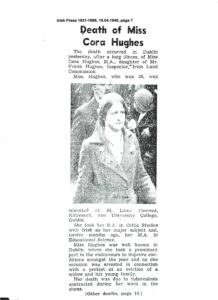
By Caroline Crowley
To those of us reared in poverty it is not so difficult to take up the cause of emancipation of the people. It is our only hope of survival. Cora could have had all the comfort in life she wanted but Cora could not eat while others hungered, sleep while others were oppressed.
When it was explained to her that the people living in the slums were victims of a social system, she added: “I know but there are people being turned out of her homes”. So, she did the logical if not the wisest thing in terms of moral code in present-day Ireland. She went into the slums and put back the furniture of a widow and her two children. For this great act of humanity, she was sentenced to jail for a month.
-Obituary to Cora Hughes 1940
The poet W.B. Yeats refers to a ‘girl’ in his poem ‘Politics’.
‘How can I, that girl standing there,
My attention fix on Roman or on Russian,
Or on Spanish politics,’
-William Butler Yeats 1938
In the late 1930s Yeats regularly took tea at the Gresham Hotel. On leaving he was often seen pausing at Findlaters Corner at the junction of O’ Connell and Cathal Brugha Street where radical groups held meetings.
Cora Hughes was born to middle class rural background in Co. Mayo to a family that was close to Eamon de Valera.
His aging muse Maud Gonne, assembled with her friend Madame Despard and a group of younger, equally defiant women on Thursday evenings. Cora Hughes a young Mayo woman with striking golden red hair, referred to as an Irish ‘Joan of Arc’, frequently addressed the crowd speaking passionately about social justice and the Republican cause in Spain.
‘The girl’, Cora, that Yeats refers to was a young activist of great courage and conviction. Hers is the story of those who struggled for liberty and equality in Ireland in the 1930s, a story of fraternity with workers, small farmers and the unemployed at home; of internationalists whose brothers and sisters fought tyranny in Abyssinia, India and Spain.

Cora who was born in January 1912 was the eldest of five children of Frank and Kitty Hughes of Kiltimagh, County Mayo. Ellen Hughes, Frank’s widowed mother, had enrolled her eldest son in the prestigious Blackrock College, Dublin where he became a close friend of Éamonn de Valera. De Valera spent Christmas of 1899 in the Hughes’ House on Main Street and was a frequent guest thereafter.
On hearing of Ellen’s death on his he was release from prison in December 1924, he wrote fondly of the Christmas he first saw Kiltimagh, recalling the walks and the evenings at the fireside.
Frank, who worked as inspector for the Congested Districts’ Board, was best man at Dev’s marriage to Sinéad Flanagan in January 1910 and they reversed roles when Frank married Kitty in August of the same year. The friends promised that each other would act as godfather to their firstborn.
Radical times
Cora was an exceptional student and had a particular interest in in Irish and History. Her special hero was Michael Davitt founder of the Irish Land League. She went to study in University College Dublin in 1930 where she joined the University branch of Cumann na mBan and the Cumann Gaelach, meeting more senior left-wing Republicans, Síghle Humphries and Frank Ryan among them. She studied James Connolly’s ‘Labour in Irish History’ becoming a very committed Socialist Republican, joining the Republican Congress, a left wing split from the IRA in 1934.
Cora studied at University College Dublin and there became a socialist republican.
The young poet Charlie Donnelly, a fellow student and activist, fell in love with Cora. They had much in common. They were both fiercely independent thinkers, rebelling against the capitalistic emphasis and social inertia of the Free State Government. Both clashed with their families because of their ideology and activism, abandoning the lecture halls for the Tenant Leagues, joining picket lines and serving jail sentences for their support of the disenfranchised.
Cora loved Charlie as a friend and fellow activist but his passion for her was unrequited. It was generally felt that he went to London and ultimately to Spain (to fight against Franco’s army and for the Republican Government) because of her romantic indifference and her relationship with George Gilmore. Gilmore was a veteran of the War of Independence, an Anti-Treatyite in the Civil War and a veteran of a trio of prison breaks from Free State jails. Cora said George had a very fine mind and that his political analysis was very precise. Their love for one another is beautifully portrayed in the ‘Gold Flag’ which George authored in play and novel form after Cora’s death.
The 1930s was a time of political turmoil in Ireland with the emergence of the Blueshirt movement
The early 1930s was a time of political turmoil. Commandant Ned Cronin founded the Army Comrades Association (ACA) comprising of ex members of the Free State army, in response to Fianna Fáil winning the 1932 election, albeit with a minority government. Thomas F. Higgins became leader in August 1932 and was joined by fellow Cumann na nGaedheal TDs Ernest Blythe and Desmond FitzGerald. In January 1933 De Valera called a surprise election in which Fianna Fáil won a majority .
Cora’s godfather became Taoiseach for a second time. Cora and Dev were very fond of one another but had different outlooks on what political and social direction the emerging state should take. Cora told Éamonn that it was not enough to put name plaques in Irish over the streets of the slums and not instigate political change that would radically improve the lives of the slumdwellers and the poor. De Valera reportedly told her that “Labour can wait”.
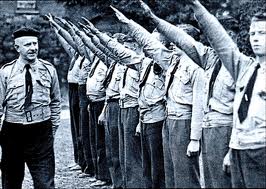
De Valera dismissed Eoin O Duffy as Garda Commissioner with O Duffy then becoming leader of the ACA. Under his leadership the organisation became increasingly fascist in statement and action, adopting fascist-style uniform and salutes, they became known as the Blueshirts. They would define themselves against not only the Fianna Fáil government but also against ‘communism’ and the left-wing republicans such as Cora Hughes and George Gilmore.
Cora first met George at a meeting in early 1933 where left wing republican Peadar O Donnell introduced them. The meeting was most likely a rally in the Rotunda against the deportation of Jim Gralton, a political agitator who established a Revolutionary Workers’ Group (RWG) and dance hall in Leitrim, in defiance of pressure from the local bishops. In February of 1933 the Government issued a deportation order against Gralton who had been born in the United States and after a period ‘on the run’ he was captured in August 1933 and expelled from Ireland.
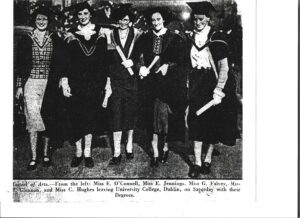
Anti-communist hysteria was fuelled by the Catholic Church and in March a Redemptorist priest preaching at the Lenten mission in the Pro- Cathedral told the congregation that there were ‘vile creatures of communism’ in the ‘holy city of Dublin’.
For three consecutive nights a hymn singing mob swelled by members of the animal gang, the ACA and St Patrick’s Anti-Communist League attacked the headquarters of the RWG in Great Strand Street.
Cora, Lil O Donnell and Dr Nora McCormick were inside Connolly House on the night of Wednesday 29 March when it was burnt down by the crowd outside. George and his brothers Charlie and Harry were among the defenders of the building helping the occupants make a perilous escape across the roof.
Cora left her studies and became involved in organising Tenant Leagues in the city centre slums
Cora Cora left her studies and became involved in organising Tenant Leagues in the city centre slums. She became a prominent member of the Republican Congress when it was formed in 1934 organising rent strikes and writing about the appalling conditions in the tenements. She was arrested with May Laverty for replacing furniture removed by a bailiff during an eviction. They were sentenced to four weeks hard labour in Mountjoy Jail. Cora and May refused to wear prison uniforms or do prison work. Cora and Charlie Donnelly led a huge contingent of slum dwellers who marched through Stephen’s Green to confront Lord Mayor Alfie Byrne about the plight of tenants evicted by landlords.
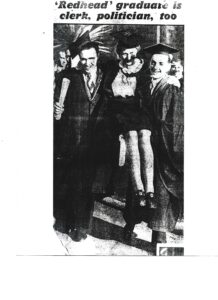
Spring 1934 was the period of Great Hunger Marches in the United kingdom and the United States. In Ireland unemployed workers marched from Cork to Dublin. When the exhausted marchers reached Dublin, their numbers were swelled with unemployed Dubliners and a large contingent of Republican Congress members led by Cora, Nora McGinley (later Harkin) and Bobby Walsh (later Edwards).Cora was a delegate to the Anti -War Congress in Sheffield in August 1934.
Speaking first in Irish she told the 530 delegates that she represented over 140 members of two Dublin groups of the Republican Congress and pledged support in fighting the growing fascist menace and the Imperialist urge for another ‘Great War’.
Civil War in Spain, agitation at home
Cora was arrested again in 1935 along with over twenty other Congress members for picketing factories during the Bacon Shops’ strike. Among those arrested were Charlie Donnelly, Bill Gannon, Jack Nalty, Eugene Downey and Joe Monks who a few years later would go to fight on the Republican side in the Spanish Civil War. Cora was a member of the Women Prisoners’ Defence League, founded by Maud Gonne MacBride, orating on many occasions with MacBride and Hannah Sheehy Skeffington, demanding the release of Republican prisoners.
Cora was on the ‘Friends of the Spanish Republic Committee’
She worked in the National Health Insurance Society where she was union shop steward and negotiated improvements in office conditions particularly related to heating. Cora was on the ‘Friends of the Spanish Republic Committee’ who hosted the Basque priest Fr Ramon LaBorda’s trip to Dublin to counteract propaganda that Franco was a defender of Christianity. At a meeting in the Gaiety Theatre on 23rd of January he told the audience that the war and the elections before it were not religious, that the Left Wing had beaten the Right Wing with votes, in the war the Rights were trying to win with guns.
On an evening in late February 1937 George Gilmore was walking up the stairs to Cora’s flat which was on the top floor of a building in the south city centre . George, who was a cynic as regards the supernatural and who knew Charlie Donnelly was in Spain, saw their Brigadista friend on the landing. A few days later they found out that Charlie was killed at the Battle of Jarama on the night George had seen his vision. Cora returned to her studies in UCD and was conferred with a primary degree in 1937 and a Masters degree in Celtic Studies in 1938.
George once described himself and Cora high up on a cliff misty with bluebells on Ireland’s Eye. As Cora traced her finger over a scar on his cheek she recalled the Blueshirts attacking them at an Easter parade in Glasnevin Cemetery. He reminded her that she had lost fistfuls of hair. George teased her about her godfather sending books to her cell in Mountjoy.
“Mountjoy or Ireland’s Eye, it doesn’t matter, they have us where they want us. The Tenant Leagues are smashed”.
Cora told him that she had seen a doctor about her cough. She had Tubercolosis.
George felt there was so little he could do for her.
“You make me very happy”, Cora said, “one day I will show you Erris”.
Illness and death
George went to her godfather to influence her parents to send Cora to Switzerland for treatment which was all that could be done for TB in those days. Her mother said it was more important to save her soul and wanted her to go to Lourdes. Cora refused. Cora suffered terribly both physically and emotionally during her illness. She spent time in the Whitworth Huts, the TB unit of the Richmond Hospital, where Éilís Ryan (sister of Frank, the leading left-republican) recalls her retrieving an engagement ring from under her pillow . She had it hidden from her parents because of their disapproval of George who was a socialist, republican and protestant.
Cora died of Tuberculosis in April 1940.
A pastel by Seán Keating shows Cora’s gaunt face, she had wasted away to skin and bone. She endured great distress given the Catholicity of the era. Her Father’s study was made into a downstairs bedroom for her where her mother put holy pictures and crucifixes on the walls. One of the pictures depicted a young woman meeting the devil in the next world. Her mother arranged for a Carmelite priest named Father Benedict to visit her daily. A basically cruel man, with strict catholic religious beliefs, he told her she would have to renounce her socialist values if she was to save her soul. Her illness had given her back to her mother in body. Leslie Daiken touchingly describes Cora’s plight in his poem ‘Shamrocks for MayaKovsky’,
“The doors of the sick-room
where the coughing girl lay wasting, the bloom
of her fine cheek, greying, greying,
As the consumption shrunk her; and the praying
Folk foregathered,
And her god-father, the Taoiseach himself
Devoutly told his beads, rejecting medical help”
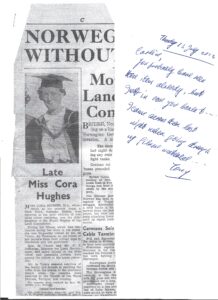
Cora’s godfather Taoiseach Eamon de Valera sat in the sitting room of the Hughes’ family home in Rathmines. Her mother Kitty fiddled with a bowl of daffodils.
“I took them from her room”, she told him. “They breathe air and she wouldn’t know today whether they are there or not”.
“We must not question the will of God”, Éamonn said. “If only she were resigned to death”.
Cora Hughes died on the 18th of April 1940. She is buried in the Hughes’ family grave in Kilkinure Cemetery just outside of Kiltimagh. At her parents request deValera ordered the gardaí attend her burial in force so the local IRA cumann could not give a gun salute over her grave.
Cora’s fiancé George did not attend the burial.
References.
- Dev and His Alma Mater: Eamonn DeValera’s Lifelong Association with Blackrock College 1898-1975, Seán P. Farragher, Paraclete Press, 1985.
- Frank O Hora, Joe Mulhearn, Tommy Gallagher, interviews with the author, Kiltimagh July 1992.
- Dr Tom Hughes, interviews with the author, Douglas, Isle of Mann, June 16 and 17, 1995.
- George Gilmore, meetings (4) with author, the Unicorn Restaurant, Dublin 1984.
- Eilís Ryan (sister of Frank Ryan), interview with author, Royal Hospital, Donnybrook,Dublin, 29 March 1994.
- The Late Cora Hughes: An Appreciation, Irish Workers’ Weekly, Sat. April 27, 1940.
- Tapestry of Memories, Dr Nora McCormick, unpublished memoir
- The Gold Flag, unpublished novel and play, George Gilmore.
- George Gilmore, reminiscences to Anthony Coughlan, courtesy of Anthony, friend of George and his literary executor.